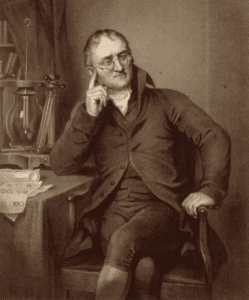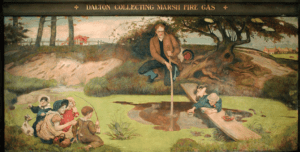JMS Pearce
Hull, England
 |
| Fig 1. John Dalton. Line engraving by W. H. Worthington, 1823, after J. Allen, 1814. Credit: Wellcome Collection. Attribution 4.0 International (CC BY 4.0) |
John Dalton (1766–1844) (Fig 1) is one of the most revered scientists of the last 250 years. His origins were humble. He was the son of Deborah and Joseph Dalton, a weaver, both members of the Society of Friends. He was born in a thatched cottage in Eaglesfield near Cockermouth in the Lake District.1 As a pupil he attended and then taught at a tiny local schoolroom in Pardshaw Hall, the site of the Quaker Meeting House. At the age of ten he entered the service of a Quaker gentleman, Elihu Robinson, a renowned meteorologist who taught him mathematics. Remarkably, by the age of twelve he had acquired enough knowledge to teach at the school for local children. It did not prosper and in 1781 he joined his brother Jonathan as a teacher in Stramongate School at Kendal (Fig 2.), which later they acquired; their sister Mary came from Eaglesfield to keep house for them. At the same school, 101 years later, Sir Arthur Stanley Eddington FRS (another Quaker) was born. His father was the headmaster.
Dalton learned science, Latin, and Greek from John Gough, a scholar blinded by smallpox, whom he regarded as a scientific prodigy. He studied tirelessly and diligently and in 1787 gave a course of lectures on natural philosophy. It is hard to imagine how a humble, prosaic schoolteacher could have acquired precociously such a reputation that in 1793 he was appointed tutor/professor of mathematics and natural philosophy at New College, Manchester (a Presbyterian institution of education for dissenters banned by Oxford and Cambridge universities). He started with a salary of about £50.00 per year. He lived the rest of his life in Manchester, working freelance from the Manchester Literary and Philosophical Society. With access to laboratories and to other scientific minds, he began to develop his own theories of meteorology and natural philosophy.
Color blindness
Dalton read his first paper on 31 October 1794 to the Manchester Literary and Philosophical Society: Extraordinary Facts relating to the Vision of Colours. Color blindness afflicted him and his brother, and became known as Daltonism. Years before, the story was that one day in Kendal, buying his mother a present he chose a somber woolen pair of stockings. Observing their gaudy scarlet red color, she told him:
Thou has brought me a pair of grand hose, John, but what made thee fancy such a bright colour? What I can never show myself at meeting in them.
Confused, Dalton verified with his brother that they were grey in color. Only when neighbors confirmed they were red did he realize that both he and his brother had a hereditary defect of color vision. Later he also observed:
I accidentally observed the color of the flower of the Geranium zonale by candle-light, in the Autumn of 1792. The flower was pink, but it appeared to me almost an exact sky-blue by day; in candle-light, however, it was astonishingly changed, not having then any blue in it, but being what I called red, a color which forms a striking contrast to blue . . . It appears therefore almost beyond a doubt, that one of the humours of my eye, and of the eyes of my fellows, is a coloured medium, probably some modification of blue. I suppose it must be the vitreous humour; otherwise I apprehend it might be discovered by inspection, which has not been done.a
Thomas Young2 and Helmholtz later established the trichromatic theory of color vision, which concluded that receptors [cones] exist in the retina for three principal colors—red, green, and blue—from which all other colors could be produced.
He made substantial contributions to the understanding of the physical sciences—investigating heat conduction, gas expansion by heat, the properties of light, the aurora borealis, and meteorology.3,4 He showed that the total pressure of a gas mixture was the sum of the partial pressure of each gas. This established Dalton’s Law of Partial Pressures.5 His writings were on diverse topics: on rain and dew and the origin of springs, on heat, the color of the sky, steam, English grammar, and on the reflection and refraction of light.1
 |
| Fig 2. Dalton & Eddington plaque at Stramongate School, Kendal. Photo by Diane Griffiths. Via Wikimedia |
Atomic Theory
After Democritus’s (c. 460—c. 370 BC) notion of a universe composed of particles in constant motion, scientists knew that all matter was made up of small particles; Dalton’s originality was his focus not on the atom (Greek atomos means uncuttable) but on atomic weight, which could be determined by systematic quantitative analysis. Thus he founded Atomic Theory, which stated: (1) that all matter is made up of small indivisible and indestructible particles called “atoms”; (2) all atoms are not alike, but all atoms of a particular element are identical; (3) the atoms constituting any one element have a definite weight; they can neither be created, destroyed, nor split; and (4) that compounds are produced by the combination of different atoms.
It followed that any compound (molecule) must consist of a definite assemblage of different atoms and have a definite weight: whence his law of constant proportion. He calculated atomic weights from the percentage compositions of compounds.1 For example, he found that twelve grams of carbon could react with sixteen grams of oxygen to form the compound carbon monoxide.
He made a list of twenty-one atomic weights, hydrogen being taken as unity: he published the first table of atomic weights as A New System of Chemical Philosophy, two volumes, (Manchester, 1808, 1810).
His homemade equipment was crude and his data not always accurate, but his powers of deduction led him to discoveries of the highest importance.6 All modern understanding of chemistry as it relates to animal and human biology and physiology, ultimately is rooted in the identity of atomic structure and the related constitution of molecules. Before John Dalton’s discovery of the laws of chemical combination, and without his atomic theory to explain those laws, chemistry as an exact science did not exist.
A.L. Smyth has compiled a bibliography of his works. The remaining John Dalton manuscripts (many damaged by a fire during World War II) are held at the University of Manchester Library.
*****
Dalton lived an abstemious and simple life as a lodger with the Rev. William Johns in Faulkner Street, Manchester.7 He taught mathematics in the Society of Friends Meeting House in George Street. He had several friends, but was “too busy to marry.” He remained a solitary man of simple needs and habits, his dull apparel and manners befitting his Quaker faith. However Jonathan Otley, his companion on many walks in the Lake District, revealed another aspect. In a letter to Peter Clare, his executor, dated Keswick 30 Aug 1844 he related “no time could ever be lost in his company; he was so affable and communicative.”
He lectured in London, Edinburgh, and Glasgow, in lucid if not flamboyant style, and taught both elementary and advanced science to many young students. In 1822, against his wishes, Dalton was elected a Fellow of the Royal Society and the first recipient of its Royal Medal; he was elected a corresponding member of the French Academy of Sciences and was co-founder of the British Association for the Advancement of Science. He received honorary degrees from the universities of Oxford and Edinburgh. His conclusions were at first only slowly accepted,6 but by the end of his life his atomic theory was universally acknowledged, though he was not always receptive to newer ideas. In 1833 he was awarded an annual pension from the King.
He had a stroke in 1837 and a second one a year later, which impaired his speech. His final attack terminated his life on 27 July 1844. He was buried at Ardwick Cemetery, Manchester.
He would have been astonished that at his death more than 40,000 people came to Manchester to pay their final respects. On Tuesday, 14 October 2003, the Royal Society of Chemistry erected a bicentenary plaque (unveiled by Nobel Prize winner, Sir Harry Kroto) in Manchester Peace Gardens. Dalton and Arthur Eddington share a green rectangular plaque (unveiled in 1998) at Stramongate School, Kendal, where Dalton taught. (Eddington was born in Kendal and his father was headmaster at the same school; he became a pioneer of astrophysics, professor of astronomy at Cambridge, and confirmed Einstein’s theory of relativity). There is a Dalton Street in Manchester city center, a marble statue of him in the town hall vestibule, and another outside the former Dalton College of Technology (now Manchester Metropolitan University). Ford Madox Brown’s (1821-1893) charming painting Dalton Collecting Marsh-Fire Gas hangs in the Manchester Town Hall. (Fig 3)
One might guess that this self-effacing, solitary genius would have been more than a little embarrassed by all the fuss.
This account is based on Pearce JMS. John Dalton FRS., (1766–1844), In: Quakers in Medicine, ‘Friends of the Truth’, Sessions of York Ebor Press 2009.
 |
| Fig 3. Dalton collecting fire gas. Ford Maddox Brown 1887. Source |
End Note
- This proved incorrect: later DNA extracted from his bequeathed eye showed that Dalton was a deuteranope, lacking the medium wavelength sensitive cones of the retina, contradicting Thomas Young’s belief that Dalton was a protanope.
References
- Roscoe HE. John Dalton and the rise of modern chemistry. London, Cassell & Co 1901 https://archive.org/stream/johndaltonriseof00roscuoft/johndaltonriseof00roscuoft_djvu.txt
- Pearce JMS. Thomas Young MD FRS (1773-1829): “The Last Man Who Knew Everything.” Hektoen Int. Fall 2020
- Dalton J. Meteorological Reflections and Essays, 1794,1799, 1803.
- Dalton J. “Experimental Enquiry into the Proportion of the Several Gases or Elastic Fluids, Constituting the Atmosphere,” Memoirs of the Literary and Philosophical Society of Manchester 1805;1, 244-58
- Dalton J. Memoirs of the Manchester Literary and Philosophical Society 1794.
- Greenaway F. Dalton, John (1766–1844) Oxford Dictionary of National Biography 2004. https://doi.org/10.1093/ref:odnb/7063
- H. Lonsdale, “Worthies of Cumberland: Dalton” (1874).
JMS PEARCE, MD, FRCP, is an Emeritus Consultant Neurologist Department of Neurology, Hull Royal Infirmary, and an author with a particular interest in the history of science and medicine.

Leave a Reply